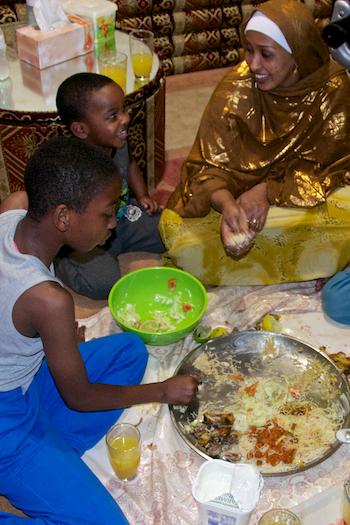Eating together
Duration/age

Sitting together as a family to share food can be a great opportunity to talk about what happened during the day or what might happen tomorrow.
If the weather is nice you could pack a picnic and sit outside or go to the park and share a meal together. If it is cold and wet you could still have a picnic, but have it inside by the fire or heater where it is nice and warm.
Before you eat, talk about how hungry each person is - so you know how much food to serve. Will each person have their own plate of food or will you put all of the food on one big plate for sharing? Let your child know who else will be sharing the meal.
We’re going to have 5 people for lunch today. We’ll need to find a space that’s big enough to fit all of us.
Ask your child to help you set up. Will you sit at a table, on a mat or somewhere else? If you are going to sit on the floor, ask your child to lay out a rug or mat. Explore together how big the mat will need to be and where it might fit.
Finally everyone is ready, the food is on the plates, the hands are washed and everyone has found a spot to sit.
Talk with your child about their day or what food there is to eat. Will your child tell you what they want to eat or will you make the choices and feed them?
We have rice, potatoes, chicken and salad. What would you like to eat?
Daddy is having chicken and rice. Would you like the same?
Materials you will need
- Food
- Family
- A place to sit
Skills this activity improves
Why does this matter?
Eating together as a family helps your child to develop language and experiment with measuring and planning.
When children help you to get organised for a meal they are leaning to quantify and compare their worlds. They do this when they follow instructions, notice patterns and use problem-solving skills to work out what needs to be done and in what order.
We have 2 more people eating today so we need a bigger mat to sit on.
What does this lead to?
When your child has the opportunity to be part of a group of people having a conversation they are learning to wait, listen and then respond to what is being talked about. Being part of the group discussion helps your child to learn language about a shared topic and to develop friendship skills.
As your child helps to organise where to eat and how food will be served they are exploring measurement and the different directions or language we use to describe measurement. They are exploring the measurement concepts of:
- number - how many people will eat?
- size - how much space do we need for the mat?
- quantity - how much food will we need for 5 hungry people?
- time - when will we eat?
Language to use
- Inside, outside
- Sunny day, cold day, wet day, weather
- Day time, night-time, lunchtime, dinner time, breakfast
- Bowl, dish, spoon, plates, utensils
- Table, mat, floor, chairs
- Sitting
Questions to use
- How hungry are you?
- Do we need a bigger dish for the food than normal?
- Where will we sit?
- Who is going to eat?
- What are we eating?
Useful tips
- You might also like to take a look at the activities Heating or cooking food for dinner and Calling the family together to eat
- Remember to talk to your child in your home language.
More ideas
- Create a special picnic basket for picnic days.
- Set up a playdough table with household objects.
Variation by age
Birth to two year olds
- Have a teddy bears’ picnic.
- Borrow books from the library about eating together.
- Let your child help to set the table.
Three to five year olds
- Have a teddy bears’ picnic.
- Borrow books from the library about eating together.
- Let your child help to set the table.
- Ask your child to help cook the food.
Questions to ask
- What are you going to eat?
- Where will you sit?
- What will you cut the chicken with?
- What do teddy bears eat?
Questions to ask
- What are you going to eat?
- Where will you sit?
- What will you cut the chicken with?
- What do you like to eat the most?
- What is Daddy’s favourite meal for dinner?
Language to use
- Inside, outside
- Table, floor, chair, rug, mat
- Day time, night-time, lunchtime, dinner time, breakfast
- Bowl, dish, spoon, plates, utensils
- Food, fruit, vegetable, spaghetti, chicken, meat, pasta
Language to use
- Inside, outside
- Table, floor, chair, rug, mat
- Day time, night-time, lunchtime, dinner time, breakfast
- Bowl, dish, spoon, plates, utensils
- Food, fruit, vegetable, spaghetti, chicken, meat, pasta


